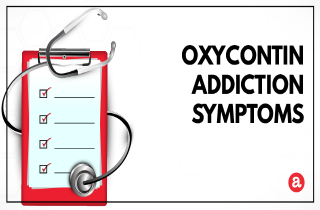How can you identify if someone is an OxyContin addict, or not? Here, we review the most common signs and symptoms of OxyContin as well as its basic treatment. Then, we invite your questions about help for Oxycontin addiction problems at the end.
OxyContin addiction signs
OxyContin (main ingredient oxycodone) is an opioid agonist product prescribed for the management of moderate to severe pain. It is primarily used as a prescription pain killer when a continuous, around-the-clock opioid analgesic is needed for an extended period of time. However, OxyContin may sometimes be used as needed for pain relief (especially for acute and postoperative pain management).
So how does OxyContin work? OxyContin alters the natural occurring chemistry in the brain, which means that it changes the way the brain works. The endogenous opioid receptors, found in the brain as part of the limbic system, brain stem and spinal cord, are all affected by OxyContin. These receptors are responsible for causing pleasure, emotions control, relaxation, breathing, coughing, body relaxation and pain management.
First signs of Oxycontin addiction
Altered dosage is the first sign that someone may be abusing OxyContin. Doses are prescribed according to several factors, such as previous analgesic experiences and ongoing pharmacological therapies. OxyContin tablets come in 10 mg, 15 mg, 20 mg, 30 mg, 40 mg, 60 mg, and 80 mg; 60-80 mg are prescribed only for patients who have developed tolerance to Oxycontin or other opioids. But if someone is taking OxyContin OTHER THAN PRESCRIBED, this is a warning sign:
- taking more Oxycontin dosage than prescribed
- taking OxyContin more frequently than prescribed
- taking OxyContin for longer than prescribed
- taking OxyContin in ways/modes of administration other than prescribed
Changes to mode of administration can also indicate a problem with OxyContin. OxyContin should be swallowed. Unfortunately, OxyContin addicts may be willing to take risks in order to get high. One of the most common ways to abuse pain killers is to crush the tablets and pills and inhale the powder (snorting Oxys). Others try to chew OxyContin rather than swallow it, breaking its time release…or smoking OxyContin on tinfoil. Dissolving OxyContin pills in water and then injecting the solution has been deterred by a new chemical formula which renders the pill difficult to inject. Still, addicts innovate new ways to try to get high.
Symptoms of OxyContin addiction
According to the The Diagnostic and Statistical Manual of Mental Disorders criteria for drug problems, addiction is currently defined as substance use disorder. Some physical, behavioral, and psychological symptoms of OxyContin addiction include:.
- behaving secretively
- being physically dependent on OxyContin
- combining OxyContin with other drugs for euphoric effect
- constant preoccupation with how to obtain more OxyContin
- continuing to use OxyContin despite negative impact on health, social, home, or work life
- disorientation, or a lost sense of time
- experiencing constant cravings and compulsion for OxyContin
- feeling a strong psychological urge for more OxyContin
- frequent changes in mood
- going through withdrawal symptoms when OxyContin doses are lowered or interrupted
- initiating unsuccessful attempt(s) to quit using OxyContin
- investing all resources in OxyContin
- lack of concentration at work, home or school
- lack of trust in other people
- not following doctor’s recommendations for OxyContin administration
- poor sexual performance
- taking more OxyContin, more often than intended over a period of few months time
- turning to criminal acts in order to get OxyContin
OxyContin addiction symptoms: Can they be treated?
Yes, OxyContin addiction symptoms can be treated.
Studies have shown that customized combination of behavioral, psycho-therapeutic and pharmaceutical approaches are the best options for treating OxyContin addiction. As with any drug addiction, OxyContin addiction is more likely to be successfully treated if identified and addressed early enough.
Many families chose to intervene in order to reach to an addict in a non-formal way. The goal of an intervention is for a person to accept OxyContin addiction treatment. Interventions for OxyContin addicts are pre-planned meetings for people closest to an addict, like family members, spouse, and children. A discussion is held directly with the addict, in order to make him aware of the negative consequences of OxyContin use. Other models, such as the CRAFT model of intervention, advocate for more long term family involvement with an addict.
Signs of OxyContin addiction questions
Want to know more about OxyContin signs of addiction? Please feel free to ask your question(s) in the following section. We will try to provide you with a personal and prompt answer.









Related Posts